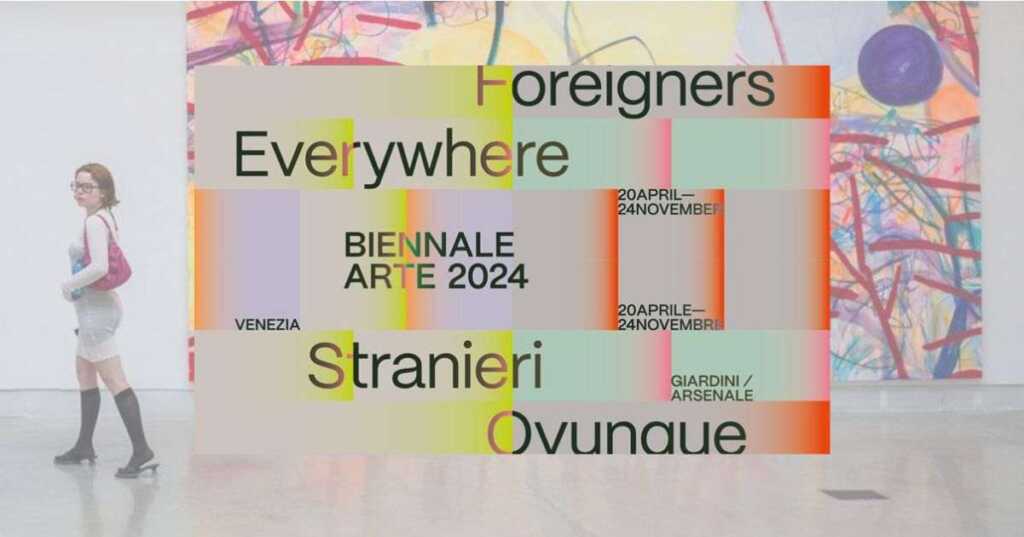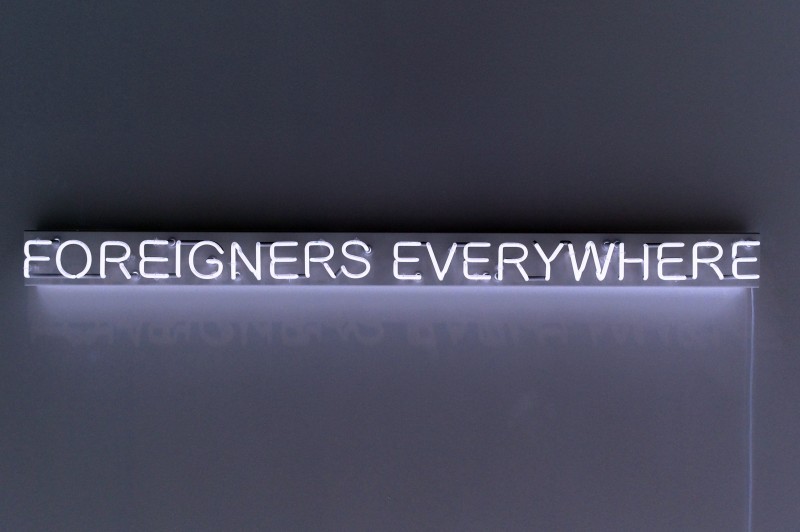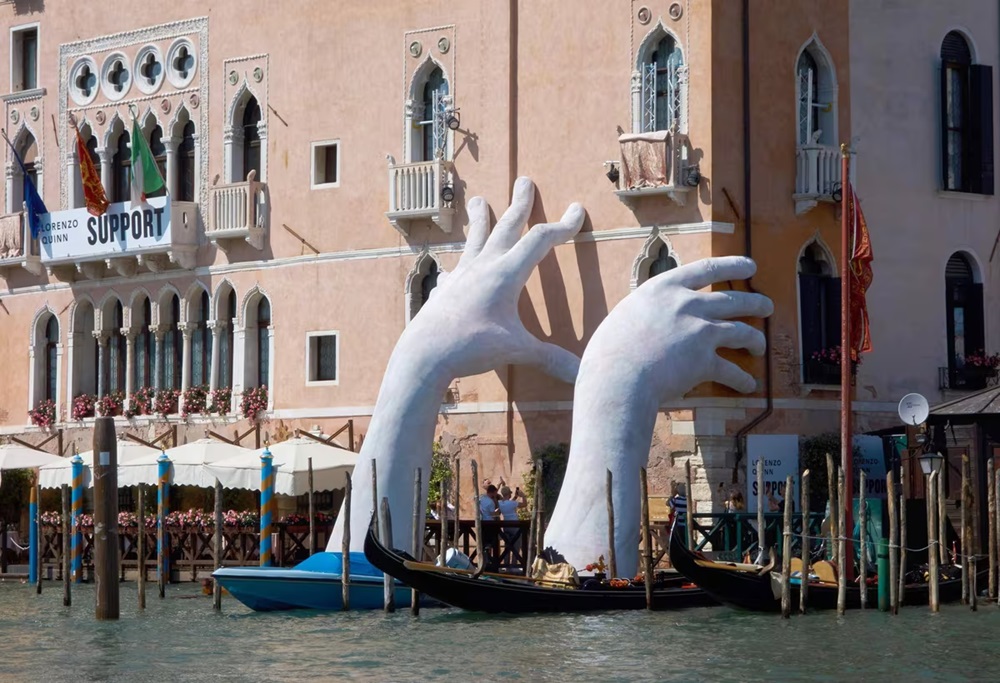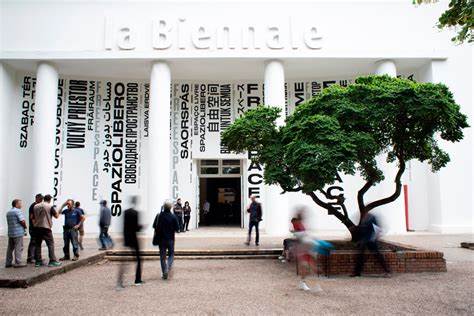The Venice Biennale 2024 showcases a remarkable confluence of artistic innovation and cultural heritage through the works of four pioneering Brazilian artists: Rubem Valentim, Waldemar Cordeiro, Judith Lauand, and Alfredo Volpi. These artists have significantly contributed to geometric abstraction, emphasising form, colour, and structure over representational content. Their unique approaches reflect their creativity and the diverse cultural and historical contexts shaping their artistic journeys.
Rubem Valentim
Rubem Valentim is a central figure in Brazilian art and a pivotal reference in twentieth-century Afro-Atlantic artistic production. His work, particularly during his “Rome Phase,” encapsulates a period of profound exploration and cultural synthesis. This phase, characterized by his brief but impactful time in Italy, saw Valentim deepening his engagement with Brazil’s African heritage, creating a unique artistic language that resonates with spiritual and cultural symbolism.

Valentim experienced the nuances of being a foreigner during his time in Italy. This state profoundly influenced his artistic journey—this period allowed him to reflect on and integrate the rich traditions of Brazil’s African heritage into his work. Central to this exploration were the symbols associated with the orixás, the deities of the African Candomblé religion practised in Brazil. Valentim’s art from this era delves into the curves and geometries of these symbols, decoding their symmetries and exploring the dialogues between pure and synthetic forms. In developing his unique artistic vocabulary, Valentim accentuated shapes and primary colours. This approach allowed him to craft a visual language where the arrangement of forms generated multiple meanings. Each composition became a word, and each arrangement a sentence, creating a dynamic and versatile lexicon of shapes. This period also reflects Valentim’s recent foray into sculpture, which influenced his three-dimensional thinking and added depth to his canvases. Rubem Valentim’s contributions to Brazilian and Afro-Atlantic art are profound and enduring. His ability to synthesize cultural heritage with modern artistic techniques has left an indelible mark on the art world. By integrating symbols of the orixás and exploring their geometric and symmetrical properties, Valentim created a body of work that speaks to his heritage’s spiritual and cultural dimensions. His work celebrates the richness of Afro-Brazilian culture and offers a universal language of form and colour that resonates across cultures.

Waldemar Cordeiro
Waldemar Cordeiro, an influential figure in the Brazilian avant-garde art scene, embarked on a remarkable journey that redefined the boundaries of artistic expression. Born in Rome in 1925, Cordeiro migrated to Brazil in 1946, a move that would prove pivotal for his career and modern art trajectory in Brazil. Within a few years, he emerged as the leader of the Concrete Art movement in São Paulo, guiding its course from 1952 to 1959. This movement, characterized by its emphasis on geometric abstraction devoid of subjectivity, found in Cordeiro a passionate and radical advocate.
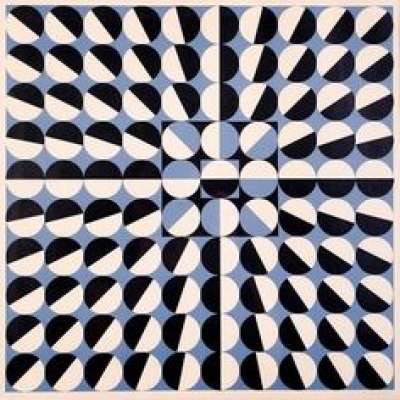
Cordeiro’s work during the Concrete Art movement was marked by a rigorous adherence to geometric precision and a commitment to eliminating personal expression in art. He employed industrial paints to eradicate any trace of handmade brushstrokes, striving for a purity of form that aligned with the movement’s principles. His art during this period was a celebration of mathematical precision and optical clarity, aimed at creating visual experiences that were both objective and universal.
In “Untitled” (1963), Cordeiro’s meticulous geometric precision gives way to a more spontaneous and personal expression. The composition features hand-painted symbols – the plus sign (+), the multiplication sign (x), and circles – set against a solid green background. This artwork is notable not for its mathematical exactitude but for Cordeiro’s evident pleasure in painting. The freehand pattern, constructed with mathematical symbols, departs from his earlier works’ optical illusions and precision. Instead, it reflects a newfound freedom and joy in the creative process. This transition period is crucial in understanding Cordeiro’s broader impact on art. It highlights his willingness to evolve and adapt, moving beyond the constraints of Concrete Art to explore new artistic territories. His incorporation of three-dimensional objects into his paintings during this phase further underscores his innovative spirit and drive to constantly push the boundaries of creative expression.
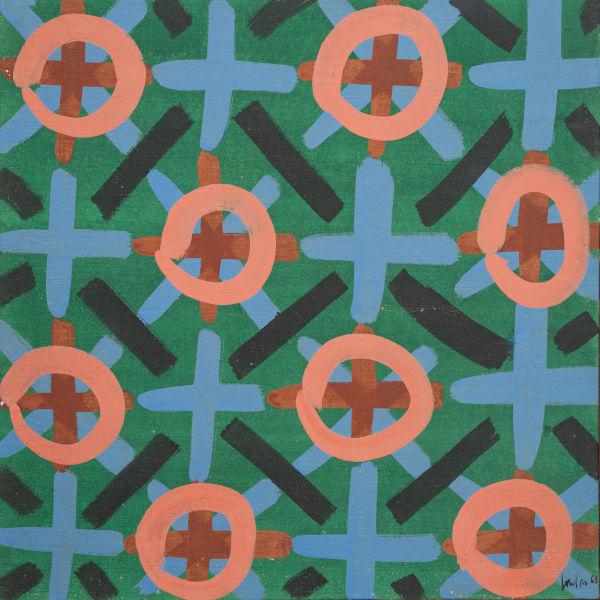
The presentation of Waldemar Cordeiro’s work at the Biennale Arte marks a historic moment. It is the first time his art has been showcased at this prestigious event, offering a global audience a glimpse into his career’s dynamic and transformative phases. The inclusion of “Untitled” (1963) provides a unique insight into Cordeiro’s transitional period, offering a testament to his evolving artistic vision and his significant contribution to modern art. Waldemar Cordeiro’s legacy extends far beyond his contributions to Concrete Art. His willingness to embrace change and his ability to merge mathematical precision with personal expression has left an indelible mark on the art world. His journey from geometric abstraction to a more liberated and personal art form inspires artists and enthusiasts, highlighting the importance of evolution and adaptability in creative practice.
Judith Lauand
Judith Lauand, born to Lebanese immigrants in Araraquara, an economic and cultural hub in the countryside of São Paulo, is a distinguished figure in the Brazilian art scene. Her journey from academic and figurative art to the forefront of concrete experimentation is a testament to her innovative spirit and dedication to pushing the boundaries of artistic expression.
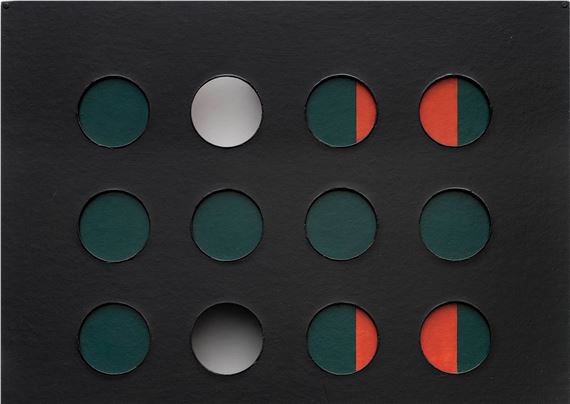
With “Acervo 290, concreto 18” (1954), Lauand solidifies her place in the annals of modern art, showcasing a unique approach that blends mathematical precision with dynamic creativity. Growing up in Araraquara, Lauand was immersed in a milieu that fostered economic vibrancy and cultural richness. This environment undoubtedly influenced her early artistic inclinations. Initially, her work was rooted in academic and symbolic traditions. However, as she matured as an artist, Lauand began to explore the principles of Concretism, a movement that emphasized abstract, non-representational art grounded in geometric forms and mathematical structures.

“Acervo 290, concreto 18” (1954) marks a significant period in Lauand’s career, highlighting her transition into Concretist art. In this piece, Lauand masterfully manipulates shapes and planes of colour to construct complex structures from simple, systematically repeated figures. The composition studies the relationship between form and space, where the interplay of elements generates a sense of rhythm and dynamism. Central to this work are the triangle and lozenge shapes, which take on various forms and configurations throughout the canvas. Judith Lauand’s ability to blend geometric abstraction with dynamic movement and colour has left an indelible mark on the art world. Lauand’s work exemplifies the principles of Concretism while also pushing its boundaries, demonstrating a versatility and creativity that continues to inspire contemporary artists. Her journey from the figurative to the abstract and her mastery of form and colour underscore her significance as a pioneering force in modern art. As her work gains recognition on the global stage, Lauand’s influence is poised to grow, solidifying her place as a critical figure in the history of Concretist art and beyond.
Alfredo Volpi
Alfredo Volpi, born to Italian immigrants, his mother hailing from Lucca and his father from Bologna, arrived in Brazil in 1897 at the tender age of one. Volpi’s artistic journey significantly turned in the 1950s during a trip to Italy, where he encountered Giotto’s frescoes. This experience sparked his interest in tempera, a painting medium based on egg white.

“Fachada Marrom” (1950s-1960s) exemplifies this pivotal moment in Volpi’s career, showcasing his exploration of geometric motifs and his engagement with Brazilian Concretism. The encounter with Giotto’s frescoes in Italy profoundly influenced Volpi’s technique and artistic direction. Fascinated by the durability and texture of tempera, Volpi began experimenting with this medium, integrating it into his work. This period marked the genesis of his geometric motifs, particularly the “nereirinhas,” which established a dialogue with the geometric abstractionism of Brazilian Concretist artists.
Alfredo Volpi’s work from the 1950s and 1960s marks a significant chapter in the evolution of Brazilian modern art. His ability to fuse traditional techniques with modernist aesthetics positions him as a bridge between past and present, tradition and innovation. Volpi’s geometric motifs and use of tempera have left an indelible mark on the Brazilian art scene, influencing subsequent generations of artists. “Fachada Marrom” is a testament to Alfredo Volpi’s mastery and innovation. By blending geometric abstraction with elements of popular culture and traditional techniques, Volpi created a unique visual language that continues to resonate in contemporary art. His work embodies a harmonious tension between the transient and the enduring, capturing the essence of Brazilian modernism. As we reflect on Volpi’s contributions, we recognize his enduring impact on the art world, a legacy celebrating the confluence of diverse influences and the power of artistic exploration.
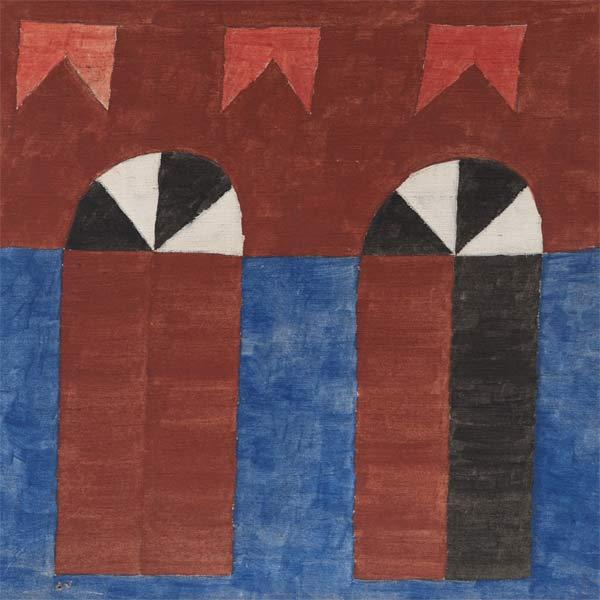

Jain Syriac Babu is a Kerala-born, Italy-based theatre artist and art enthusiast.

